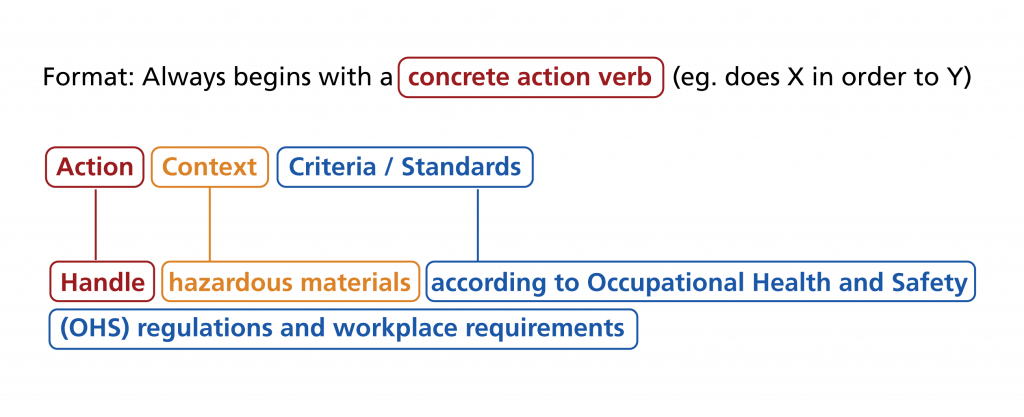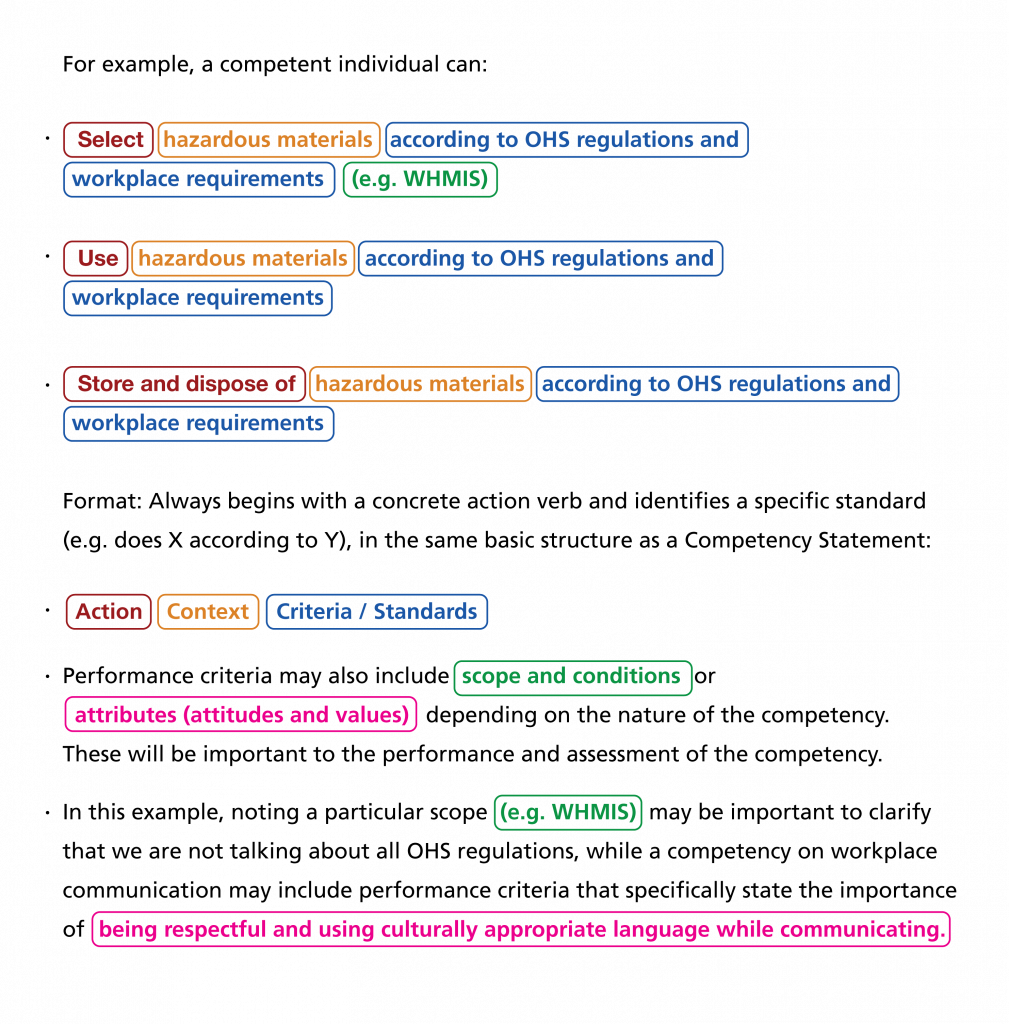5 How to construct a competency
When it comes to creating or revising a competency framework, it’s important to consider the components of each competency. To ensure that you capture the necessary information to build your competency framework, we propose the following components, which align with the templates we provide in the toolkit.
Title (or Name) – A short name that identifies the competency and is useful in distinguishing it in the framework. Taking the action verb and context from the competency statement is a good place to start.
- Example: Handle Hazardous Materials
Competency Statement – A descriptive statement that states what a competent individual is doing, and in what context.

Show/Hide alternative (text) version of the competency statement illustrated above
- Format: Begins with a concrete action verb (e.g. does X in order to Y) and contains both context and criteria/standards
- Example: Handle hazardous materials according to Occupational Health and Safety (OHS) regulations and workplace requirements
Defining Terms:
Concrete Action Verb = a measurable verb that states actions which can be observed and measured when used in the context of an activity or task.
Context = What the nature of the action is (i.e. the object of the verb)
Criteria/Standards = specify the criteria for expected performance (e.g. to what level, to which standard, scope etc.)
Performance Criteria – A list of measurable outcomes required to demonstrate proficiency in the competency.
Note: Expected performance criteria can look very similar to a competency statement. So, what’s the difference? Expected performance criteria are all the observable behaviours or sets of activities that a person must be able to do to demonstrate the competency. In order to achieve the competency listed above in the competency statement, the performance criteria list what a competent individual can do. In particular “handling” would include selecting, using, storing, and disposing of hazardous materials.
- A stem (such as “a competent individual can:”) may precede the list or be implied
- The performance criteria are the basis for both informal and formal assessment

Show/Hide alternative (text) version of performance criteria illustrated above
For example, a competent individual can:
-
- Select hazardous materials according to OHS regulations and workplace requirements (e.g. WHMIS)
- Use hazardous materials according to OHS regulations and workplace requirements
- Store and dispose of hazardous materials according to OHS regulations and workplace requirements
- Format: Always begins with a concrete action verb and identifies a specific standard (e.g. does X according to Y), in the same basic structure as a Competency Statement:
- Action > Context > Criteria/Standards
- Performance criteria may also include scope and conditions or attributes (attitudes and values) depending on the nature of the competency. These will be important to the performance and assessment of the competency.
- In this example, noting a particular scope (e.g. WHMIS) may be important to clarify that we are not talking about all OHS regulations, while a competency on workplace communication may include performance criteria that specifically state the importance of being respectful and using culturally appropriate language while communicating.
Supporting Knowledge and Skills – What do you need to know, and be able to do in order to achieve the competency? These inform training requirements and learning outcomes.
- Examples:
-
- Must know and understand the correct identification and handling of hazardous materials (e.g. there may be a requirement to complete WHMIS training in procedures, symbols, etc.).
- Must be able to read and interpret product labels and instructions.
Key Terms and Definitions – A list of key terms and definitions required to provide clarity about the descriptors used in the competency and/or performance criteria statements. Such terms are often bolded in the statements or compiled in a central glossary. Definitions can limit scope or identify variations in scope.
- Examples:
-
-
Hazardous materials: Substances that can cause harm and that require specific handling to use safely. Most hazardous materials found in the workplace fall under WHMIS requirements for handling and use.
-
Occupational health and safety (OHS) regulations: Legal requirements for working safely, which may include required training and certification, maintaining workplace documentation, and reporting of any incidents or near misses.
-
WHMIS: Workplace Hazardous Materials Information System; a system of site specific information about hazardous materials that are present and how to use and handle them safely.
-
Workplace requirements: As determined by the workplace and management; requirements specific to a particular workplace and/or job role.
-
The crucial information you need to have for developing a competency framework is:
- the competency statement,
- the performance criteria,
- the supporting knowledge and skills, and
- the key terms and definitions.
What you include in your framework beyond these key components depends on the purpose of the framework and who is using it. The next section goes into more depth on the purpose of frameworks, which will help guide the development of your framework, and the additional components below are included in the templates and examples we provide in the toolkit.
Context and Examples – These are not always included in the description of individual competencies but are important to a framework. The templates found in the appendix includes places to capture this information.
- How is this competency relevant to a job role, organization, or industry sector?
- How might it be demonstrated in different contexts and environments?
- These add tangible examples of how the competency is applied
- Additional examples can be added unique to different users
- Examples:
- Workers may use hazardous materials for tasks such as cleaning and sanitizing, and must do so safely. This may include mixing or diluting concentrated chemicals according to the instructions provided by the supplier
- Supervisors and managers are also responsible for ensuring that everyone has the proper training and knows where to find specific information on the safe use of each hazardous material found in the workplace.
Learning Content / Links
- Learning content should connect with the supporting skills and knowledge as well as the performance criteria
- Is there specific learning content related to this competency or a group of competencies?
- Is there a formal training requirement?
- Examples:
- Links to WHMIS Training (formal training course)
- Links to OHS regulation (supporting knowledge related to this competency for review)
- Links to workplace-specific OHS policies and procedures
Assessments
- Which competencies and behaviours are being measured, and how?
- Are multiple competencies being assessed at the same time?
- Formal assessments often require a rubric or specification tied to a proficiency scale
- These are developed separately to allow flexibility in how the competency and expected behaviours are measured in different contexts.
- Examples:
- WHMIS test/Certification (knowledge component; possibly regulatory requirement)
- Observation of individual handling hazardous materials while doing related tasks (practical component)
Connections to (or within) a Competency Framework – Categories and other links
- How does this competency tie into groupings or categories within a framework?
- How does this competency relate to other competencies (e.g. as a pre-requisite or requiring one)
- Linkages to occupations and how they apply (e.g. criticality, frequency, complexity)
- Examples:
- Categories – Workplace safety, Common core (ie everyone needs this)
- Unique Identifier or Code – this allows the organization of competencies in a logical manner and makes them machine-readable
Concrete action verbs are also known as measurable verbs. They state actions which can be observed and measured when used in context with an activity.
measurable outcomes required to demonstrate proficiency in the competency

